As the metroid counter winds down, Samus Aran enters the final areas of the game. SR-388 offers one last cavern super-structure followed by a couple of smaller tunnel networks that house the climactic encounters. Now that Samus has every piece of gear in hand, the game doesn’t feel particularly compelled to play nice…
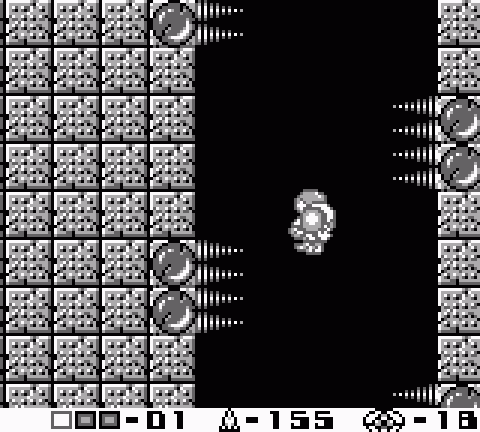
Including this nasty bit of work.
At this point, a contemporary player will probably start to feel the lack of backtracking. You’ve acquired all these tools and skills, yet you don’t have to revisit any previous portions of the game to explore sections that were off-limits to a less empowered heroine. Instead, you press ahead toward the end, which makes the game feel a lot shorter than it actually is. This isn’t necessarily a bad thing; the Metroid Prime series, even at its best, showed how easily backtracking can go from “compelling test of observation and awareness” to “tedious slog to stretch a few hours of gameplay into more.”
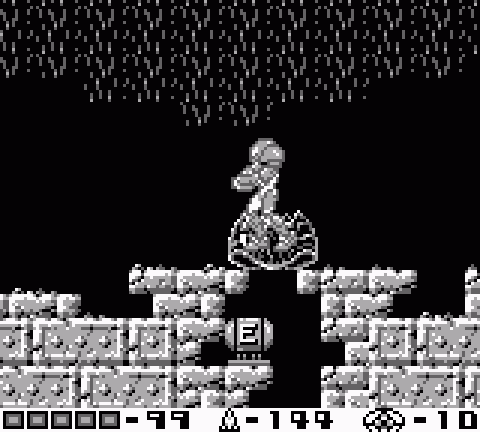
Instead, you’ll see level design puzzles like this Energy Tank, which looks like it should be a cinch to grab, as you can sometimes you can drop through metroid husks — but not this one. Instead, you have to roll through a separate passage and find your way through a pitch-black room by bombing unseen blocks in Spider Ball form to create a route. To make it extra-tricky, the dark room contains a Missile Expansion that’s quite easy to reach, which could fake you out into thinking you’d grabbed the prize in the confusing black chamber. It’s a clever one-time gimmick that could easily overstay its welcome, but since it only shows up once it instead feels like a novel application of your Spider Ball and orienteering skills.
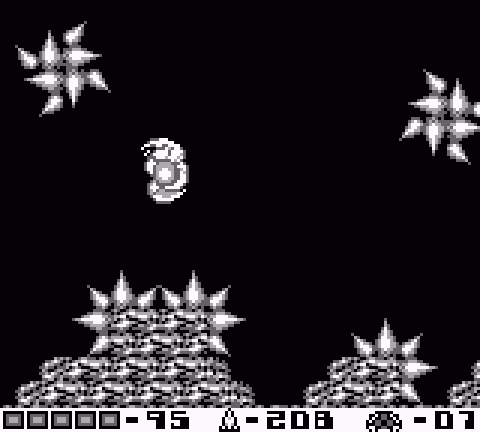
And instead of sending you back to retrace your steps, Metroid II offers challenging sequences like this, which demand mastery of the Space Jump. This room does kind of overstay its welcome, since you have navigate four of them in both directions. Then again, they’re really not that big a deal. By this point, you should have maxed out Samus’ health and collected the Varia Suit, which means you could pretty much walk through the spikes and be fine.
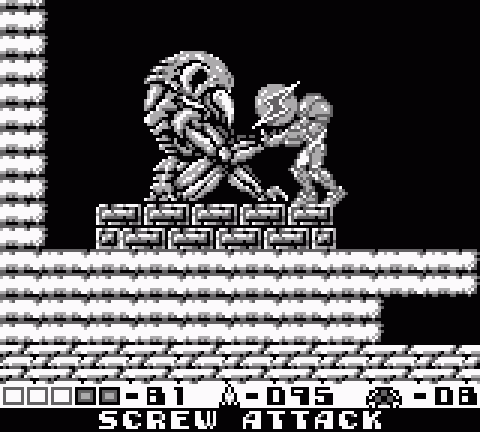
This area’s reliance on the Space Jump feels less burdensome than the earlier region’s thanks to the handy appearance of the game’s last significant power-up, the Screw Attack. The Screw Attack of course turns Samus’ acrobatic flip into a weaponized action, rendering her touch deadly (or at the very least blunting an enemy’s attack and granting her invulnerability). Now, if you can maintain a Space Jump, you’ll destroy everything in your path as you go save a handful of enemies that require more specific tactics. This doesn’t help clearing those rooms of spiky protuberances, but it makes moving through the final big cavern much easier. It also lets you brush away metroids when they start crowding you — you can jump into a mutant metroid and force it backward to give yourself some breathing room in the midst of close encounters.
The final cavern space is otherwise unremarkable save one interesting feature: The central structure houses a tall shaft which branches off into multiple offshoots, each containing a different one of Samus’ possible weapon types. You can’t combine weapons at this stage of Samus’ career, but you can pick your poison for the final batch of metroid encounters.
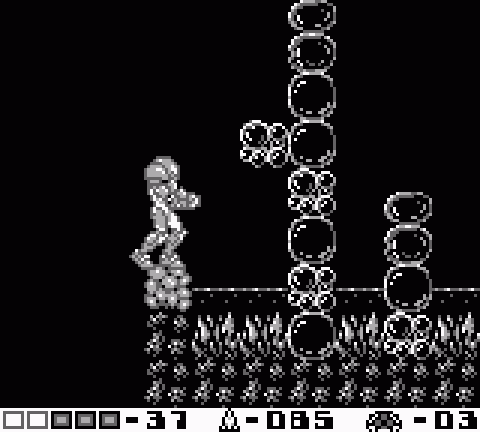
With the metroid counter sinking into lower single-digits, you can move beyond the fourth and final major section of the game and into the endgame. The scenery here takes on a familiar appearance for fans of the series, replicating the bubble-like rock formations of Metroid‘s Norfair region. I’m not sure if this was meant simply as a casual callback to the previous game or if there’s meant to be some other meaning. Maybe this is how Metroid‘s graphic designers think you should represent the inner depths of a planet? Or maybe the idea is that metroid somehow terraform their surroundings to share their gelatinous appearance, kind of like the resin secretions that Aliens‘ xenomorphs coat their nests in (never mind that there weren’t any metroids living in Norfair).
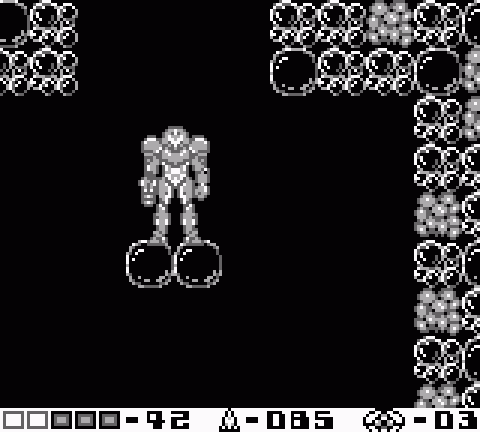
Is this real life? Is this just fantasy? No, it’s just a visual flashback as you prepare to encounter the nastiest metroids in the game: Omega metroids.
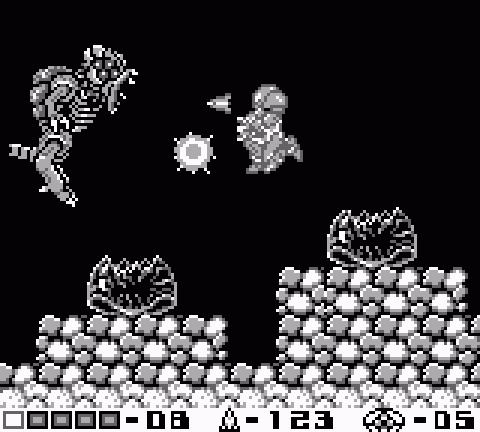
If you’ve only ever seen the omega form based on the one at the end of Metroid Fusion, you may be surprised by how relatively small they appear in Metroid II. They’re barely taller than Samus, and nowhere near as bulky as their redrawn versions. They also can’t take your health down to 1HP in a single swipe, which is nice. However, they are tough.
Omegas behave a lot like zetas — they hover slightly above Samus, blast her with projectiles, make swooping attacks, and attempt to destroy you. In keeping with the exponential strength curve of the metroid evolution chain, omegas take a full 40 missiles to put down — though, like zetas, you can pepper the vulnerable spot on their backs with missiles to make things considerably easier on yourself. An omega metroid hits Samus for 12 HP per attack (24 if you somehow missed the Varia), so these amount to battles of attrition. Because omegas are so large, and so fast, it’s nearly impossible to avoid their diving attacks… and 40 missiles is a lot to score with in that amount of time.
The final omega battles are made all the more difficult by the fact that very few lesser creatures appear in this final loop, and there are no charging points. If you run low on health and missiles — and you will! — you either need to grind for refills on the few mundane beasts that appear in these chambers or else backtrack to the refill points in the fourth and final cavern. The further you delve into the depths of SR-388, the more insecure you feel; there’s no “home” or safe spot in the entire game, and this final push really plays on that. I do feel that the lack of convenient energy and missile restoration here works to the game’s detriment, though. You’ll either need to waste time retracing your steps or waste time killing the same few enemies over and over, neither of which increase the game’s difficulty. They just make things more time-consuming and annoying.
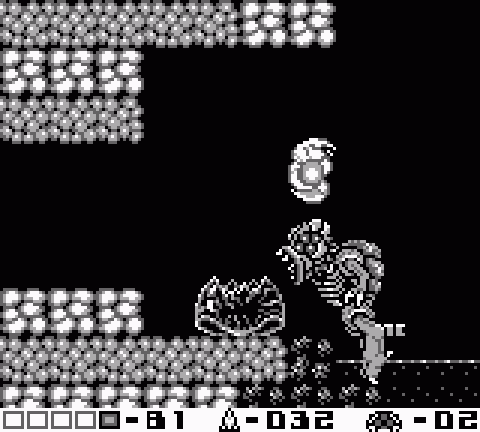
The game also does a nasty trick with its earthquakes — at one point you kill a metroid and a quake strikes… which fills in a previously open passage. You’re forced to hunt down the remaining metroid in this area before you can advance. It’s a small moment and not a particularly difficult one, but it’s harrowing; it offers a surprise twist on a recurring game mechanic to trap you right as you begin to feel that the adventure is winding down.
When you whittle the metroid counter down to one, a final earthquake drains the acidic fluid from the shaft located in the center of the final omega cavern loop, and you can advance to destroy the very last metroid.
After reading this one, I now have the desire to go back and play this game. It has been pretty close to 10 years since I last played it, so maybe it is time to return to this game.
While I have an original copy of the game, I am tempted to pick up the Virtual Console version.
Loving this series on one of my favorite original Gameboy games. Many hours were slain running through the caverns of this little treasure. Thanks for the clarity in the discussion of the mechanics and series callbacks, Mr. Parish.
Thanks for doing Metroid II Jeremy. I am a bad video game player and I never actually beat the original metroid on NES (and some how still haven’t to this day despite playing zero mission quite a few times). Metroid II was the first one I ever beat. So doing this right after Kid Icarus for the NES, which I also only finished on gameboy, kinda takes me back to a more carefree time.
Can’t wait to see what game is next. If it’s Kirby’s Dreamland I am gonna need to be pinched to make sure I am not still in elementary school.
One thing I really LOVE about Metroid II is that gradual reduction in non-metroid enemies as you get deeper into the game.
Yes, it makes healing between battles more difficult, but when you combine it with the progression of enemy designs(each deeper area has progressively tougher-looking enemies, some with armor plates that can deflect Samus’ weaponry), it turns the tension up quite effectively.
Things are more dangerous, the metroids are more aggressive, and the weaker life forms have all perished. Presumably at the claws of our title antagonists.
This all peaks in the final area, where there simply ISN’T any non-metroid life. It’s dark, quiet, and foreboding in a way few games are.
Then there’s the final ice beam chamber. That is my single favorite room in any Metroid game. But I’ll save that commentary for later.
One nifty little consequence of the Omega’s weak spot is that it means your initial allotment of missiles (30) is a bit more than sufficient to kill one of them. In the strictest sense of the term, the game never lets you be under-equipped.
Thanks for doing these Metroid 2 posts - I have never played the game, and I had not realized how much Super Metroid had drawn from Metroid 2. Not just some of the abilities, but also the graphics.
@Scott: You can add plot elements to your list - just wait for the final part of this anatomy and you will understand what I mean (if you do not already know).
These posts inspired me to get my old Metroid II cart out of storage. Much to my surprise I beat the game in just two days - I was just too slow to get the “best” ending. The linear structure really keeps you moving forward and the game isn’t that difficult anyway.
I’ve played a lot of old GameBoy games over the past two years, but this one really stands out for me. First is the technical aspect. Usually action games on the GameBoy move slow and often suffer from slowdown, but neither is the case in Metroid II. I also really liked the use of music. Not so much the ambient music in Metroid lairs, but the sound that bookends these parts of the game. And the whole final lair is masterfully executed I think.
I was also surprised at how different the game feels when played on a Super GameBoy and a GBC/A. On SGB backgrounds have a light color, but on the GBC/A the world is suitably dark. Both systems go out of their way to make sure Samus is colored red, so I played the latter half on the go. I feel the game really holds up well after all these years.